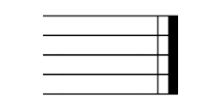How do you find the end of the piece?

***student plays***
“Oh? You did not learn the notes on the next page?”
“I thought it was over at the end of the previous page … ^^;”
“In this edition (G. Schirmer), the last measure of page 35 is tacet (rest for one full measure), but how do you know that this is the end? “
“… hmm …”
“You will see a double bar at the end of a piece.
There are two kinds of double bar
A double bar is literally two vertical lines on the music staff.
There are two kinds of double bar:
One is two vertical lines of the same thickness, which indicates the change of sections, or the key change, or the time signature change.
For example, the double bar of this Kaiser 27 at the page 36 looks like this:

It’s a bit hard to see, but this is the double bar with the thick line on the right side, and again it means the end of this etude.

The other is two vertical lines with one thick line on the right side, which indicates the end of the piece.
For example,


The double bar marked in red, shown above, which is the one on the left; both lines are the same thinness, indicating the first variation (one section of this piece) ends here, but the piece still continues.
Thus, if there is no double bar with a thicker right side, the piece is not over yet.Be sure to learn all the notes till you see the double bar.”
I’m listed in Feedspot violin blogs: https://blog.feedspot.com/violin_blogs/